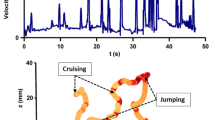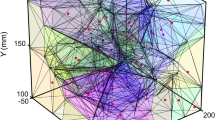Abstract
Copepods of the species Acartia tonsa have been placed in a laboratory generated turbulent flow system, called Agiturb, characterized by Taylor-scale-based Reynolds numbers from 130 to 360. Trajectories of alive and dead copepods, and of polystyrene spherical particles of size 600 \(\upmu \)m, have been measured in the dark with infrared lights, using a high speed camera at 1200 fps. Using adequate filtering, horizontal velocity and acceleration measurements have been performed. The velocity probability density functions (PDF) of dead copepods are very close to the one of material particles of the same size. The PDFs of alive and dead copepods are different for low Reynolds numbers, and become superposed for Reynolds numbers larger than 160. On the contrary, the PDFs of accelerations of alive and dead copepods are also different for medium values of the Reynolds number, and become superposed for Reynolds numbers larger than 270. This shows that copepods’ swimming behaviour occurs and is detectable under moderate turbulence, and not for high intensity turbulence. This gives information about the so called optimal turbulence levels for Acartia tonsa copepods and shows that when turbulence is of too high intensity, these copepods have no specific behavior.













Similar content being viewed by others
Data Availability Statement
This manuscript has associated data in a data repository.
References
R. Margalef, Sci. Mar. 61(Suppl 1), 109 (1997)
F.G. Schmitt, Turbulence et écologie marine (Ellipses, 2020)
M. Estrada, E. Berdalet, Sci. Mar. 61(supl. 1), 125 (1997)
F. Peters, C. Marrasé, Mar. Ecol. Prog. Ser. 205, 291 (2000)
P.A. Jumars, J.H. Trowbridge, E. Boss, L. Karp-Boss, Mar. Ecol. 30(2), 133 (2009)
B.J. Rothschild, T.R. Osborn, J. Plankton Res. 10(3), 465 (1988)
H. Pécseli, J. Trulsen, Ø. Fiksen, Prog. Oceanogr. 101(1), 14 (2012)
H.L. Pécseli, J.K. Trulsen, Ø. Fiksen, Limnol. Oceanogr. Fluids Environ. 4(1), 85 (2014)
H. Ardeshiri, F.G. Schmitt, S. Souissi, F. Toschi, E. Calzavarini, J. Plankton Res. 39(6), 878 (2017)
T. Kiørboe, A Mechanistic Approach to Plankton Ecology (Princeton University Press, Princeton, 2008)
P. Cury, C. Roy, Can. J. Fish. Aquat. Sci. 46(4), 670 (1989)
S. Sundby, P. Fossum, J. Plankton Res. 12(6), 1153 (1990)
B.R. MacKenzie, T.J. Miller, S. Cyr, W.C. Leggett, Limnol. Oceanogr. 39(8), 1790 (1994)
Y. Lagadeuc, M. Bouté, J.J. Dodson, J. Plankton Res. 19(9), 1183 (1997)
A.W. Visser, H. Saito, E. Saiz, T. Kiørboe, Mar. Biol. 138(5), 1011 (2001)
L.S. Incze, D. Hebert, N. Wolff, N. Oakey, D. Dye, Mar. Ecol. Prog. Ser. 213, 229 (2001)
R.E. Fontana, M.L. Elliott, J.L. Largier, J. Jahncke, Prog. Oceanogr. 142, 1 (2016)
E.J. Buskey, Mar. Biol. 79(2), 165 (1984)
T. Kiørboe, E. Saiz, M. Viitasalo, Mar. Ecol. Prog. Ser. 143, 65 (1996)
D.M. Fields, J. Yen, J. Plankton Res. 24(8), 747 (2002)
R.J. Waggett, E.J. Buskey, Mar. Biol. 150(4), 599 (2007)
M. Moison, F.G. Schmitt, S. Souissi, L. Seuront, J.S. Hwang, J. Mar. Syst. 77(4), 388 (2009)
L. Sabia, M. Uttieri, F.G. Schmitt, G. Zagami, E. Zambianchi, S. Souissi, Zool. Stud. 53(1), 1 (2014)
O.M. Gilbert, E.J. Buskey, J. Plankton Res. 27(10), 1067 (2005)
F.G. Michalec, S. Souissi, M. Holzner, J. R. Soc. Interface 12(106), 20150158 (2015)
E.J. Buskey, D.K. Hartline, Biol. Bull. 204(1), 28 (2003)
E.J. Buskey, P.H. Lenz, D.K. Hartline, Mar. Ecol. Prog. Ser. 235, 135 (2002)
T. Kiørboe, A. Andersen, V.J. Langlois, H.H. Jakobsen, T. Bohr, Proc. Natl. Acad. Sci. 106(30), 12394 (2009)
T. Kiørboe, A. Andersen, V.J. Langlois, H.H. Jakobsen, J. R. Soc. Interface 7(52), 1591 (2010)
G.I. Taylor, Proc. R. Soc. Lond. Ser. A 146(858), 501 (1934)
B.J. Bentley, L.G. Leal, J. Fluid Mech. 167, 219 (1986)
B. Andreotti, S. Douady, Y. Couder, J. Fluid Mech. 444, 151 (2001)
S. Wereley, L. Gui, Exp. Fluids 34(1), 42 (2003)
F. Akbaridoust, J. Philip, I. Marusic, Meas. Sci. Technol. 29(4), 045302 (2018)
R.R. Lagnado, L.G. Leal, Exp. Fluids 9(1), 25 (1990)
D.E. Stearns, R.B. Forward, Mar. Biol. 82(1), 85 (1984)
J.H.S. Blaxter, B. Douglas, P.A. Tyler, J. Mauchline, The Biology of Calanoid Copepods (Academic Press, Cambridge, 1998)
Y.J. Pan, E. Déposé, A. Souissi, S. Hénard, M. Schaadt, E. Mastro, S. Souissi, Aquac. Res. 51(7), 3054 (2020)
Y.J. Pan, W.L. Wang, J.S. Hwang, S. Souissi, Front. Mar. Sci. p. 1386 (2021)
S.B. Pope, Turbulent Flows (Cambridge University Press, Cambridge, 2000)
H. Tennekes, J.L. Lumley, A First Course in Turbulence (MIT Press, Cambridge, 1972)
G.A. Voth, A. La Porta, A.M. Crawford, J. Alexander, E. Bodenschatz, J. Fluid Mech. 469, 121 (2002)
N. Mordant, E. Lévêque, J.F. Pinton, New J. Phys. 6(1), 116 (2004)
R. Ni, S.D. Huang, K.Q. Xia, J. Fluid Mech. 692, 395 (2012)
T.C. Granata, T.D. Dickey, Prog. Oceanogr. 26(3), 243 (1991)
J. Jimenez, Sci. Mar. 61(suppl. 1), 47 (1997)
T. Kiørboe, E. Saiz, A. Visser, Mar. Ecol. Prog. Ser. 179, 97 (1999)
T. Kiørboe, J. Plankton Res. 33(5), 677 (2011)
H. Ardeshiri, I. Benkeddad, F.G. Schmitt, S. Souissi, F. Toschi, E. Calzavarini, Phys. Rev. E 93(4), 043117 (2016)
L.A. van Duren, J.J. Videler, J. Exp. Biol. 206(2), 269 (2003)
T. Kiørboe, H. Jiang, R.J. Gonçalves, L.T. Nielsen, N. Wadhwa, Proc. Natl. Acad. Sci. 111(32), 11738 (2014)
D.M. Fields, J. Yen, J. Plankton Res. 19(9), 1289 (1997)
D.R. Webster, D.L. Young, J. Yen, Integr. Comp. Biol. 55(4), 706 (2015)
D. Elmi, D.R. Webster, D.M. Fields, J. Exp. Biol. 224(3), jeb237297 (2021)
G. Dur, S. Souissi, F.G. Schmitt, F.G. Michalec, M.S. Mahjoub, J.S. Hwang, Hydrobiologia 666(1), 197 (2011)
D. Adhikari, B.J. Gemmell, M.P. Hallberg, E.K. Longmire, E.J. Buskey, J. Exp. Biol. 218(22), 3534 (2015)
E. Saiz, M. Alcaraz, G.A. Paffenhöfer, J. Plankton Res. 14(8), 1085 (1992)
P. Tiselius, Limnol. Oceanogr. 37(8), 1640 (1992)
E. Saiz, Limnol. Oceanogr. 39(7), 1566 (1994)
E. Saiz, T. Kiørboe, Mar. Ecol. Prog. Ser. 122, 147 (1995)
F.G. Schmitt, L. Seuront, Physica A 301(1–4), 375 (2001)
F.G. Michalec, F.G. Schmitt, S. Souissi, M. Holzner, Eur. Phys. J. E 38(10), 1 (2015)
Acknowledgements
We thank Capucine Bialais and Emilien Deposé for helping with the cultures of copepods and size measurements. Daniel Schaffer is thanked for helpful advice with MATLAB codes. Nicolas Mordant is thanked for very useful recommendations on the trajectory processing.
Funding
This work has been financially supported by the European Union (ERDF), the French State, the French Region Hauts-de-France and Ifremer, in the framework of the project CPER MARCO 2015-2021.
Author information
Authors and Affiliations
Corresponding author
Appendices
Appendix 1: Particle tracking and trajectory extraction
In this appendix, the tracking algorithm is presented. It allows the extraction of particles successive positions, from the video images recorded at 1200 fps using the high speed camera. As a first step, the background is subtracted to the videos corresponding to the same turbulence intensity. In each case, the background is acquired while agitation was running without particles.
The tiny spots in video images, corresponding to copepods or particles, can be followed according to relevant parameters specifying their size, separation and intensity. A threshold is applied to automatically detect, for each frame, all particles. In order to detect only particles situated in the focal plane (a plane about 1 cm thick, Fig. 3), a maximum intensity is set to the 1\(\%\) percentile, and the threshold is set to 35\(\%\) of the maximum intensity. After finding features, a refinement provides sub-pixel precision coordinates by means of a least-squares fitting with a radial model function able to locate the center of brightness. To link the coordinates in time, from one frame to the other, a prediction framework is used, that relates the coordinates that are the closest in space and that have matching displacement directions. The center of brightness was allowed to move from one image to another with a maximum velocity of 50 cm/s (search range of 6 pixels considering the pixel/meter coefficient which is 68.4 \(\upmu \)m/pixel).
A given particle is allowed to disappear from the tracking only for one image, and in this case during the post-processing an interpolation of the missing value is done from the two neighbored values. During a video sequence, many particles can be detected simultaneously, and finally individual particle trajectories are recorded. Only trajectories where the particle was travelling at least 30 pixels in one direction or another were selected (and example is shown in Fig. 14).
Appendix 2: Estimation of Lagrangian velocity and accelerations using a convolution with a Gaussian-based kernel
To calculate Lagrangian velocity and acceleration from the reconstructed horizontal trajectories, a convolution with a Gaussian-based kernel is performed. This kernel is based on the Gaussian PDF with a width of \(\omega \):
The Lagrangian velocity is estimated by performing a convolution of the trajectory with the derivative of this kernel [43, 44]:
The acceleration is obtained from a convolution with the second derivative of the kernel:
In practice the convolution is done locally, i.e. the kernel is set to 0 when \(|\tau |>3\omega \). Such truncation needs a slight linear correction to the kernels, which is found by stating that the kernel \(g_1\) convoluted with the x function must give the value 1, and convolution of the kernel \(g_2\) with the \(x^2\) function must give the value 2.
Effect of the filter length \(\omega \) relative to the Kolmogorov time scale \(\tau _{\eta }=(\nu /\epsilon )^{1/2}\) obtained from the Vectrino measurement, on the acceleration variance \(<a_y'^2>\) when applying the convolution of the kernel \(g_2\) to the trajectories of polystyrene particles under 900 rpm
Furthermore, the value of \(\omega \) must be chosen. If \(\omega \) is too large, there is too much smoothing and the true velocity and acceleration are minored. If too small, small-scale noise and errors in measurement may lead to spurious large values of the velocity and acceleration. An objective way to estimate this value is to vary \(\omega \) and estimate the acceleration variance for each value of \(\omega \). When it is too low, the acceleration variance will diverge. This is illustrated in Fig. 15 for the 900 rpm case. The filtering time scale \(\tau _f=\sqrt{2}\omega \) is normalized by the Kolmogorov time scale \(\tau _{\eta }=(\nu /\epsilon )^{1/2}\). The acceleration variance is modelled by a power law when the filter length gets close to 0 [42, 44]. When \(\omega \) corresponds to 15 points, the ratio \(\tau _f/\tau _{\eta }\) goes from 0.075 at 250 rpm and 0.6 at 900 rpm: this choice corresponds to the scale below which the acceleration variance is diverging.
The filtering time scale is hence modified for each turbulence intensity (different values for each rotation rate). This is done for each trajectory, so that a database of Lagrangian velocity and acceleration time series is obtained. Some examples are shown in Fig. 16: the x, y positions during a series of three jumps are shown together with the corresponding velocities and accelerations. This illustrates the sporadicity of jumps, which last around 50 ms. This shows that a sampling frequency of the order to 1000 fps is needed to resolve correctly these copepod jump events. However, to resolve the most “explosive” jump events, a larger sampling frequency might be necessary.
Rights and permissions
About this article
Cite this article
Le Quiniou, C., Schmitt, F.G., Calzavarini, E. et al. Copepod swimming activity and turbulence intensity: study in the Agiturb turbulence generator system. Eur. Phys. J. Plus 137, 250 (2022). https://doi.org/10.1140/epjp/s13360-022-02455-7
Received:
Accepted:
Published:
DOI: https://doi.org/10.1140/epjp/s13360-022-02455-7







